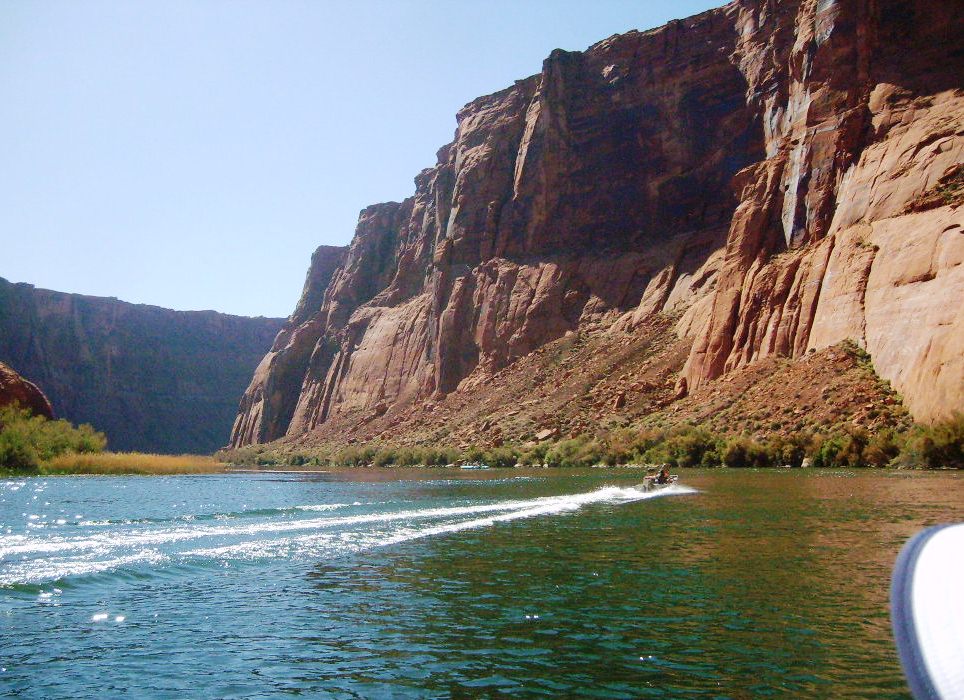
Science writers afloat in Glen Canyon
Cruising the Colorado River near Glen Canyon Dam as a faster boat goes by. Photo by Charlie Petit.
From a distance while heading north on Route 89 from Flagstaff, Glen Canyon looks dinky. From atop the dam when you get there, the blue float boats on the Colorado River way down on the south side look dinky too. The river doesn’t look very big either. Ditto for the modest little building down there just above the dam’s base where the penstocks (immense pipes) deliver water to the turbines to turn the generators that can put more than a gigawatt of power into the high tension lines marching off every which way.
But all are huge. The rim of the dam is wide as a freeway. The turbine hall looks big enough inside for a drag race. Each GE generator is broad enough for a dance floor on top. The boats hold 20 people easily and have four inflated hull tubes as big around as oil barrels, pushed by BIG Honda outboards. As much fun as it may be, a ScienceWriters meeting is pretty much hotel rooms, quick gabfests in the halls, and the occasional lab visit or cab ride to a restaurant. Flagstaff’s old town has charm. But this slice of Arizona on the day after sessions ended at ScienceWriters2011 made that cliché about the Big Sky of the American West seem the only fitting term for the excursion’s setting. The clear skies, distant horizons, crazily eroded rock formations, thousand-foot riotously stained but mainly red sandstone walls, and a river into which you do not want to fall (it comes out of the dam, from the reservoir’s depths, at about 45 degrees F) emphasized the oversized scale of things in canyon country.
It was a super finale for 60+ members of the science writing gang–a happy residue of the 330+ at the meeting–who signed up for the raft trip. No rapids, so no scary moments, but there were giddy ones watching golden eagles, ospreys, ducks feeding in the shallows with their tales up and heads straight down, blue herons, leaping trout (not natives but introduced rainbows and German browns). The (unfortunately unfulfilled) hopes of spotting a condor during the four-hour (or was it five?) trip added drama. Even the pit stop was scenic, the outhouses (each guaranteed to be green as a latrine can be) looking almost charming against the straight-up canyon walls. Nearby, we goggled at petroliths made centuries, even millennia ago by the hunting and farming cultures of the time, Puebloans and others. We shook our heads at tales of the occasional modern visitor who sneaks around the barrier to enhance the ancient works with his own name chipped into the dark desert varnish. One is pretty sure it’d be a he in each case, such people being idiots and probably powered by beer.
Thank you to dam manager Lonnie Gourley and others with the Bureau of Reclamation who took us through the massive structure’s innards. Thank you to the naturalists from local research institutions and chiefly Northern Arizona University, host and sponsor of the New Horizons portion of ScienceWriters2011, plus the river company’s boat handlers. The theme was “floating a river at risk.” We got an earful on that motif and more: why most of the layering around there is laid so flat (except where a fault had rumpled them), why the tamarisk trees crowding the river banks and even sprouting from cliffs overhead are so hateful but why the imported beetles that dutifully are defoliating them bring new problems. We heard about the cultures that used to live here, and the costs and benefits of such huge dams as this and their huge reservoirs (geography lesson: Lake Powell is above Glen Canyon Dam, while well downstream on the other side of the Grand Canyon proper are Hoover Dam and its Lake Mead). Thanks particularly to NAU’s Peter Friederici for organizing the raft trip, and further thanks to him and others who from behind the scenes helped to keep New Horizons running smoothly once NASW’s always well-oiled workshops finished up.–Charlie Petit
Enjoy Charlie’s photo album at the CASW Facebook site: ScienceWriters2011: floating the Colorado